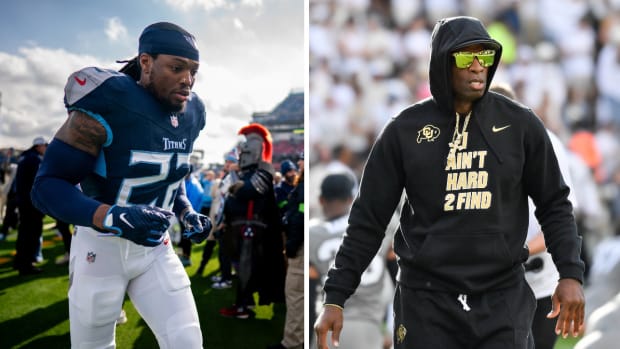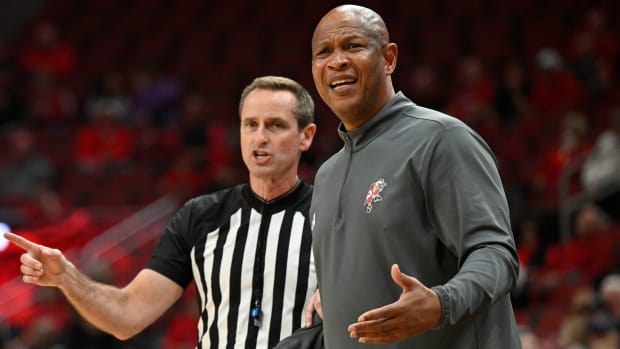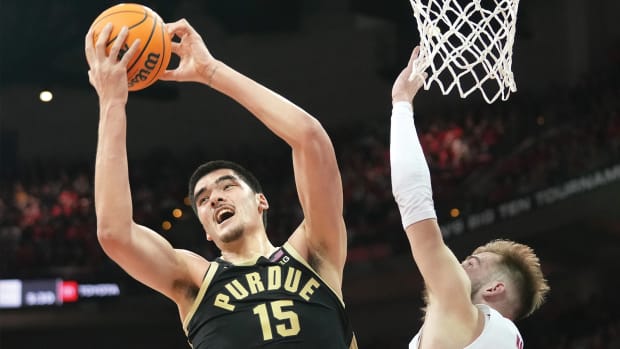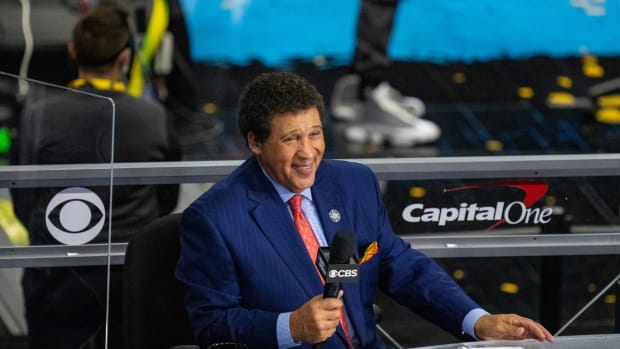NCAA Expected to Adopt Permissive NIL Solution
NCAA officials are targeting a new, simplified solution to allow athletes to profit from their name, image and likeness—just in the nick of time, too.
The organization, having abandoned exhaustive NIL legislation that’s been ready for months, is expected to now adopt a more permissive, alternative model most similar to the one proposed last week by six Division I conference commissioners, sources tell Sports Illustrated.
A week before a cascade of state laws threatens to plunge college sports into a proverbial inequitable playing field, the NCAA Division I Board of Directors, the division’s highest ranked governing body made up of school presidents and chancellors, is scheduled to meet virtually Thursday and further explore the alternative model.
The model, a stopgap until Congress can pass a uniform bill to govern the issue, removes guardrails in the original legislation that would have conflicted with the bevy of state NIL laws taking effect July 1. The proposal attempts to level the playing field for athletes enrolled at schools residing in states without an NIL law, potentially granting them unfettered access to strike NIL deals.
Under the plan, effective July 1, the NCAA would mostly exempt itself from NIL. Schools in states with an NIL law may follow that law without penalty, and schools located in states without a statute are granted permission to each create and administer their own NIL policy, as long as they use guiding principles such as prohibiting NIL ventures designed as pay-for-play or recruiting inducements.
The proposal, drafted by the NCAA's staff and legal team in light of Monday’s ruling from the Supreme Court, comes five days after commissioners Greg Sankey (SEC), Jim Phillips (ACC), Larry Scott (Pac-12) and three other league executives sent a similar model to NCAA leaders, encouraging them to punt on permanent legislation and instead adopt an alternate solution.
As part of this solution, the Board of Directors would not create new policy but would grant relief of existing legislation, sources say, such as waiving the enforcement of NCAA bylaws that prohibit athletes earning compensation from their NIL.
The timeline for this process begins Thursday with the board’s virtual meeting, followed by a meeting Monday by the NCAA Division I Council, the organization’s policy-making group of conference commissioners and school administrators. The Council is expected to provide feedback to the board, which would meet again on Wednesday to give final approval to the plan, adopting it a day before the all-important July 1 deadline date.
“We’re running out of time,” says one administrator.
While predictable after Monday’s Supreme Court decision, the move is a stunning, 11th-hour pivot to avoid both more legal challenges and an uneven landscape across college sports. The high court’s Alston ruling—a unanimous NCAA loss—is at least partially behind the decision to explore the alternative proposal. Multiple sports law experts told SI earlier this week that language in the Supreme Court’s opinion makes it difficult for the association to pass any legislation that restricts athlete NIL compensation, or risk an avalanche of antitrust lawsuits. The NCAA’s original legislation features a host of restrictions in governing athlete endorsement deals, business ventures and public appearances.
The alternative model offers a simplified, streamlined approach that, depending on each school’s plan, could grant just as many rights to athletes as permissive state laws. In this plan, the NCAA is avoiding responsibility, placing the onus on schools and conferences to draft their own proposals to avoid legal issues, says Darren Heitner, a sports law professor in Florida who helped draft that state’s NIL law.
“If the NCAA says to its school, ’This is up to you! We’re taking a hands off approach!’ Then the NCAA can effectively argue, if sued, that it has nothing to do with it,” he says. “If each school is able to create its own NIL rules, without colluding, even if they mirror each other, that shouldn’t be a problem from an antitrust perspective.”
However, many institutions in states without an NIL law were preparing to follow the NCAA’s original, 30-page legislative proposal. Now, days before the July 1 effective date, these schools and their conferences must scramble to create NIL policies themselves with little guidance or oversight. Schools now have the choice to operate under more restrictive rules with guardrails or create a completely unrestricted policy.
For the institutions and conferences themselves, there are qualms with both. In a restricted model, schools are at risk of being lambasted by the public and their own athletes and setting themselves up for a disadvantage against rival programs with more athlete-friendly rules. In an unrestricted model, schools are in jeopardy of facing conflicts with their own sponsors and uncomfortably violating what were decades-long NCAA rules.
“They’re racing. They’re in a tough spot and are trying to come up with rules on the fly and it’s difficult to do,” says Michael McCann, a law professor and sports law expert who recently testified in front of Congress about NIL. “Normally when people or groups try to race to get legal documents drafted, it’s not ideal.”
McCann describes the alternative plan as a “largely open market” and permissive enough to potentially avoid lawsuits. But, he says, “while the two guiding principles are logical, how are they enforced?”
Not everyone is on board with the alternative model. In fact, this quandary—the unrestricted, alternative solution vs. the NCAA’s more restrictive permanent legislation—is a divisive issue that has led to robust debate and somewhat fractured feelings among high-level conference administrators.
Some say the alternative plan “goes way too far” and that they’d prefer to begin with more restrictive rules before slowly working toward a more permissive model. One Power 5 administrator even described the new solution as “disrespectful” to the NCAA NIL working group, which spent two years drafting the original legislative proposal.
“Clearly we have differences of opinion on the legal issues around this,” says one high-level administrator. “You’ve got a number of states with different standards. Different groups are coming to different conclusions on addressing that.”
At least six states have an NIL law that takes effect July 1: Texas, New Mexico, Mississippi, Alabama, Florida and Georgia. Thirteen more states have passed laws that take effect at a later date, including two, Nebraska and Oklahoma, that could kick in at any point. Five more bills await a governor’s signature to become law, including an Oregon bill that takes effect July 1.
While their basic foundations are similar, the statutes slightly differ in details, some more restrictive than others. But none of them limits athletes NIL ventures as the NCAA’s original legislation—a proposal rife with athlete restrictions.
Most notably, the legislation prohibits athletes from using school marks and logos in endorsements, outlaws them from using school facilities for NIL activities and bans them from using university-provided content in NIL ventures. The impending conflicts between state law and the NCAA’s original legislation were at the root of a similar alternative solution floated by six commissioners, who penned a letter to Division I Council members last Friday with their plan attached, documents of which are available here.
In a brief interview with SI on Wednesday, Sankey says that while he appreciates the two years of work from the NCAA’s working group, the original legislative proposal was created during a different environment—before the release of the high court’s decision and the passage of a host of state NIL laws.
“What I have asked repeatedly is for leadership to be open to an alternate approach. That request is now presented in boldface print and underlined with an exclamation point,” Sankey told SI. “We do think we have to be attentive to how we make decisions after Monday’s decision. That is a view shared by many. Even if it’s not shared, that’s reality.”
And so, with time running out in the proverbial NIL game, the NCAA is gearing up to scrap its year-long plan and boom a punt downfield, hoping that, eventually, the federal government will save the day.
“It really is going to be the wild west,” says Gabe Feldman, a Tulane law professor and expert on NIL matters. “The NCAA has to hope it is temporary. Can the egg be unscrambled with a federal law?”
Temporary solution or not, even using the alternative model, Feldman says the NCAA is likely to see more courtroom challenges.
“There is no perfect answer,” he says, “from the NCAA’s perspective.”
More NCAA Coverage:






